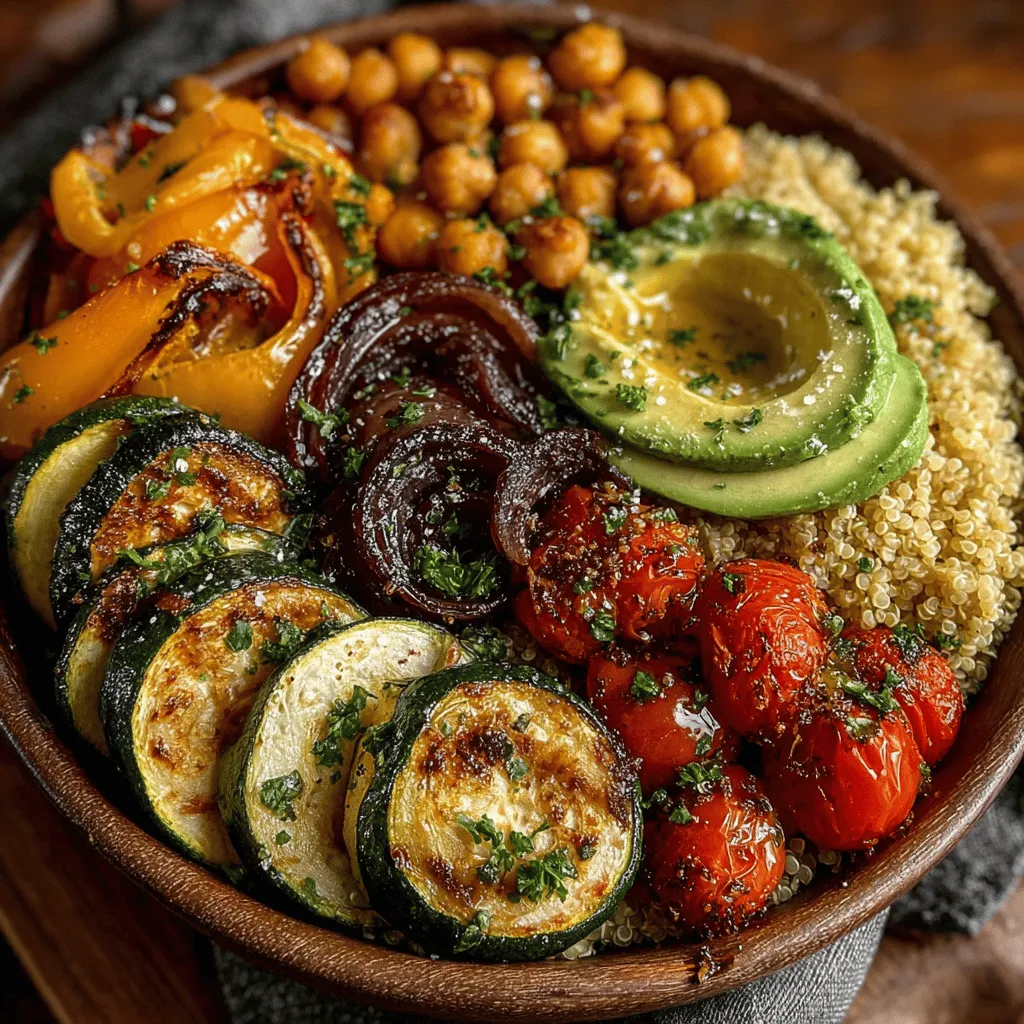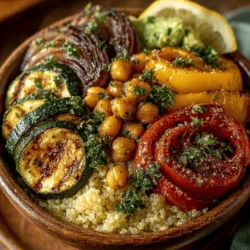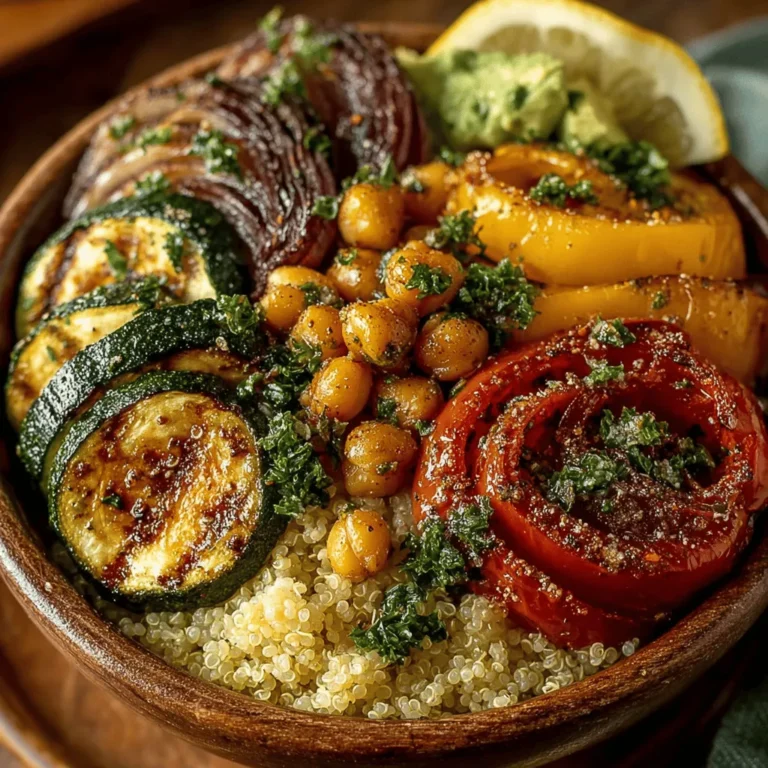In recent years, plant-based meals have surged in popularity, appealing to health-conscious eaters and culinary enthusiasts alike. Among the many delightful plant-based recipes, Quinoa and Roasted Veggie Power Bowls stand out as a nutritious, delicious, and easy-to-make option. This dish combines the wholesome goodness of quinoa with a vibrant mix of roasted vegetables, creating a meal that is not only visually appealing but also packed with essential nutrients.
Quinoa, often hailed as a superfood, is a complete protein source and an excellent addition to any diet. Paired with roasted vegetables, this dish offers an abundance of vitamins, minerals, and fiber, making it a powerhouse for your health.
Ingredients
– 1 cup quinoa
– 2 cups water or vegetable broth
– 1 medium zucchini, diced
– 1 red bell pepper, diced
– 1 cup cherry tomatoes, halved
– 1 red onion, chopped
– 1 can (15 oz) chickpeas, drained and rinsed
– 3 tablespoons extra virgin olive oil
– 1 teaspoon garlic powder
– 1 teaspoon smoked paprika
– Salt and pepper to taste
– Fresh herbs (such as parsley or cilantro) for garnish
Instructions
1. Preheat your oven to 425°F (220°C).
2. Rinse the quinoa under cold water in a fine-mesh strainer.
3. In a medium saucepan, combine the rinsed quinoa and water or vegetable broth. Bring to a boil, then reduce to a simmer, cover, and cook for about 15 minutes, or until the quinoa is fluffy and the liquid is absorbed.
4. While the quinoa is cooking, prepare the vegetables. In a large bowl, combine the diced zucchini, red bell pepper, cherry tomatoes, red onion, and chickpeas.
5. Drizzle the vegetables and chickpeas with the extra virgin olive oil, then sprinkle with garlic powder, smoked paprika, salt, and pepper. Toss until everything is evenly coated.
6. Spread the vegetable mixture evenly on a baking sheet and roast in the preheated oven for 20-25 minutes, or until the veggies are tender and slightly caramelized.
7. Once the quinoa is cooked, fluff it with a fork and set aside.
8. Assemble the power bowls by placing a serving of quinoa at the bottom, topping it with the roasted vegetables, and garnishing with fresh herbs.
The Nutritional Benefits of Quinoa
Quinoa is often referred to as a “super grain” because it is one of the few plant foods that provide all nine essential amino acids, making it a complete protein source. This quality makes quinoa an excellent option for those following vegetarian or vegan diets. Additionally, quinoa is rich in dietary fiber, which can aid in digestion and help maintain a healthy gut. It also contains essential vitamins and minerals, including magnesium, iron, and B vitamins, which contribute to overall health and wellness.
Exploring the Health Benefits of Roasted Vegetables
Roasting vegetables not only enhances their natural flavors but also helps in retaining their nutrients. The combination of zucchini, red bell pepper, cherry tomatoes, red onion, and chickpeas in this recipe offers a variety of health benefits. Zucchini is low in calories and high in water content, making it a great addition for hydration. Red bell peppers are packed with vitamins A and C, while cherry tomatoes are a good source of antioxidants like lycopene. Chickpeas provide plant-based protein and fiber, promoting satiety and digestive health. Including a colorful array of vegetables in your diet ensures a wide range of nutrients and contributes to a balanced and healthy lifestyle.
Ingredients Breakdown for Quinoa and Roasted Veggie Power Bowls
The ingredients for Quinoa and Roasted Veggie Power Bowls are not only nutritious but also versatile. Using high-quality components like extra virgin olive oil and fresh herbs can significantly enhance the flavor and health benefits of the dish. Optional seasonal vegetable substitutions can be made based on availability, allowing you to customize the recipe to suit your preferences and the time of year. Utilizing fresh, seasonal produce can create a more flavorful and nutrient-dense meal.
Step-by-Step Instructions for Preparation
The step-by-step instructions provided above ensure that even novice cooks can successfully prepare this delicious dish. By following the outlined process, you will create a wholesome and satisfying meal that is perfect for lunch, dinner, or meal prep. The combination of quinoa and roasted vegetables makes for a hearty and nutritious bowl, appealing to a wide range of tastes and dietary preferences.

Tips for Perfectly Cooked Quinoa
Cooking quinoa may seem straightforward, but achieving that perfect fluffy texture requires attention to detail. Here are some expert tips:
1. Rinse Before Cooking: Always rinse quinoa under cold water to remove its natural coating, called saponin, which can impart a bitter taste. Use a fine mesh strainer for best results.
2. Water Ratio: The standard water-to-quinoa ratio is 2:1. For every cup of quinoa, use two cups of water or broth for added flavor.
3. Control the Heat: Bring the water to a boil, then reduce to a simmer and cover. Cooking on low heat prevents water from evaporating too quickly, leading to undercooked quinoa.
4. Let It Rest: Once cooked, allow the quinoa to rest for 5-10 minutes off the heat. Fluff it with a fork before serving to separate the grains.
Techniques for Optimal Roasting Results
Roasting vegetables enhances their natural sweetness and creates a delightful texture. Follow these techniques for the best results:
1. Cut Uniformly: Chop vegetables into similar-sized pieces to ensure even cooking. Smaller pieces will caramelize better and cook faster.
2. Use High Heat: Roast at a temperature of 425°F (220°C) to achieve a perfect golden-brown exterior. Higher temperatures help in caramelization.
3. Don’t Overcrowd the Pan: Spread vegetables in a single layer on the baking sheet. Crowding can lead to steaming rather than roasting, resulting in soggy veggies.
4. Toss with Oil and Seasonings: Use a good quality oil and season generously with salt, pepper, and your choice of herbs or spices before roasting to enhance flavors.
Flavor Enhancements and Customization Options
Elevate your power bowl with these suggestions:
Additional Toppings
– Crumbled Feta Cheese: Adds a creamy, tangy flavor that pairs well with roasted vegetables.
– Tahini Drizzle: A rich, nutty addition that brings depth to the dish.
Spice Variations
– Cumin and Paprika: For a warm, smoky flavor profile.
– Curry Powder: To infuse the dish with an exotic flair.
Protein Options
– Grilled Chicken: Perfect for those who prefer meat, adding lean protein to the bowl.
– Tofu: A great plant-based alternative; marinate and grill or bake for extra flavor.
Assembly and Presentation of the Power Bowls
The visual appeal of your power bowl can enhance the dining experience. Here’s how to assemble it:
1. Layer Strategically: Start with a base of quinoa, then add a variety of colorful roasted vegetables. This layering not only looks beautiful but also allows for balanced flavors in each bite.
2. Garnish Thoughtfully: Fresh herbs like cilantro or parsley not only add color but also a burst of freshness. A squeeze of lemon or lime juice can brighten the dish.
3. Serve Stylishly: For special occasions, consider using a larger serving bowl for sharing. For meal prep, use clear containers to showcase the vibrant ingredients.
Storage and Meal Prep Tips
To make the most of your quinoa and roasted veggie power bowls, follow these storage and prep tips:
1. Storing Leftovers: Keep any leftovers in airtight containers in the refrigerator. They should be consumed within 3-4 days for optimal freshness.
2. Meal Prepping: Cook your quinoa and roast a variety of vegetables at the beginning of the week. Store them separately and assemble bowls as needed.
3. Dietary Versatility: This recipe is adaptable for various diets—vegan, gluten-free, and more. Customize your toppings and proteins to fit dietary needs.
Conclusion
Quinoa and Roasted Veggie Power Bowls are a nutritious and satisfying meal option packed with health benefits. From the protein-rich quinoa to the nutrient-dense vegetables, each bowl is a wholesome choice that can easily be tailored to individual tastes. Incorporating this recipe into your meal planning can lead to healthier eating habits and the joy of sharing delicious food with family and friends. Embrace the joy of cooking and enjoy the process of creating nourishing meals that bring loved ones together.


